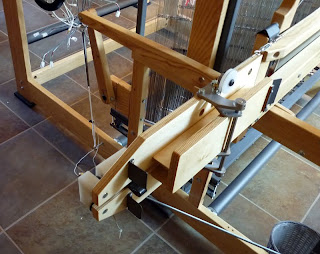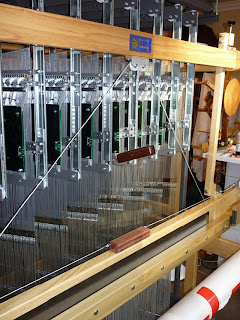First, folks, this is the business end of the array of solenoids on each jacquard module:

Each solenoid is maybe 1/4-inch wide. There are 120 of them on each module. What you see from this angle is not actually the solenoids themselves, but rather the spring and pin on the end of each solenoid. The cables leading to the heddles go through the end of the spring assembly, and when the loom driver says to pop the solenoid, the cable is pushed into position to be grabbed by the "knife" that lifts or lowers the heddle.
Anyway, what we accomplished today centered first around the double-box fly-shuttle beater. It took an inordinate amount of time, but then it's a complicated piece of equipment.


I've never actually used a double-box fly-shuttle beater. It has a completely different means of throwing the shuttle. The single-box beater (which I have on the 24-shaft loom) has a side-to-side pull cord. The double-box (or 4-box) beater has a downward pull cord. This will be a new learning (actually, muscle-training) experience for me. A good time to train myself to pull with the left hand, and give the right hand a break :^)
Also, today we installed the sandpaper beam, the cloth storage system stuff, and the auto-advance hardware. In this picture, you can see the sandpaper beam and the forward cloth storage pulley The sandpaper beam is still wrapped in its shipping paper - we don't need to sandpaper our hands or arms quite yet.

As of dinner time, the E-lift motor (the red thing hanging off the right side of the loom) is installed, the Dial-a-Sett chain is in place, and all the jacquard module power and data cables are connected to the control box (the huge grey box on the floor in the picture below):

The control box is larger than it needs to be, but when I add more jacquard modules, part of the empty real estate inside the box may be occupied by an additional power supply.
Tomorrow, we will probably power up the control box and start testing the jacquard modules. They can be tested without having the warp threaded and ready to weave. We just want to watch individual heddles rise and fall in accordance with a test file. Probably the first file will be the one I posted a few days ago, which lifts one heddle at a time. That should tell us if all the solenoids are firing as expected.



2 comments:
When I hear the cheers, I know where they are coming from--the other coast.
is there a photo of your dh next to the purgatory points dictionary entrance? if not i'll amend that :)
Post a Comment